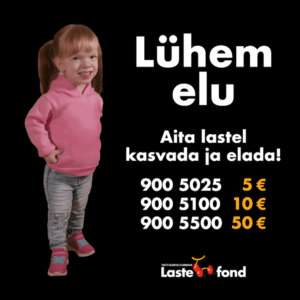
A shorter life. Help children grow and stay alive!
Tartu University Hospital Children’s Foundation’s main campaign of 2023 invites people to support children with rare diseases, for whom the development of science and medicine has created new possibilities for treatments, but whose only hope of receiving said treatments still rests solely on the shoulders of good donators.
This year’s Children’s Foundation’s main campaign “A shorter life. Help children grow and stay alive!” is aimed at children diagnosed with achondroplasia and more broadly at all patients with rare diseases and the financing of their treatments. Currently these families, including children, regrettably have no other option but to literally come to the streets and ask for aid from generous people to get the necessary money for treatments. To change this, a social agreement is needed – EVERY CHILD COUNTS! EVERY PERSON COUNTS!
4-year-old Tessa and 5-year-olds Sander-Lucas, Lara, and Kateryna are united by a rare congenital disease – achondroplasia, which manifests itself in the form of short and disproportionate growth – human limbs that are extremely short and the head is relatively large. The disease does not affect a person’s mental abilities, but they do have many serious health problems – for example, a 2-year-old child has to endure severe back and leg pain.
Until now, there has been no perceivable treatment for achondroplasia. However, now there is a medication that has been granted permission by the European Medicines Agency, which significantly improves the quality of life of children diagnosed with achondroplasia, but it is extremely expensive – the treatment of one child costs more than 200,000 euros per year. The Estonian Health Insurance Fund has denied the request for exceptional funding for the medication, referring to limitations within the law. Unfortunately, it takes 1081 days for new medications for rare diseases to enter the list of healthcare services in Estonia. Children do not have that time – in this specific case, after three years of waiting, the treatment would no longer have any significant effects. And in the cases of many other rare diseases, there would be no more patients left to treat after three years.
With the support of the good donators of the Children’s Foundation, all four children started their treatments last year. In order for their treatment to continue, nearly 1 million euros are needed per year. This amount of money would not even be obtainable in wealthy families, and it is also a large amount for a charity fund.
5-year-old Sander-Lucas lives with his family on the fourth floor of an apartment building. Before starting the treatment he could not reach the fourth button of the elevator, even when he was standing on his tiptoes. In half a year, while receiving the new treatment, Sander-Lucas has grown 3.5 cm, and now he makes sure no one else presses the important button on the elevator. This emotional moment is indeed just one tiny detail for an ordinary person, but what effect does it have on the boy and his independence? Treatment gives Sander-Lucas a chance to grow up and live a fulfilled life.
According to The Children’s Foundation’s strategy manager Siiri Ottender-Paasma, the evaluation criteria for new medicines in Estonia has remained essentially unchanged for almost 19 years: “Only changing the law is not enough, we also need a desire to find meaningful solutions to enable treatments for patients with rare diseases. Every year doctors diagnose nearly 1,000 cases of rare diseases that also affect family members and close relatives of all patients, who cannot just be pushed aside by saying that treatment is not cost-effective.”
This year’s state budget allocated 800,000 euros to the Tartu University Hospital Children’s Foundation, to help children and families with rare diseases. This was the first bold step toward finding a solution. Now it is necessary to move forward – the Children’s Foundation currently supports a total of 51 children with rare diseases, of whom 19 need medications that are not available to them without the help of the foundation’s good donators. The amount required for treatments reaches up to 2.5 million euros per year.
How many centimeters does a child have to grow in order for their treatment to be supported? How is the 50 percent effectiveness of treatments measured? When does a child’s life become cost-effective? One thing is certain – no child’s treatment options can and must not remain out of reach due to indecision – it is in the power of all of us to work together and find solutions. Every child counts! They really do count!
Additional information:
Siiri Ottender-Paasma
Tartu University Hospital Children’s Foundation’s strategy manager (member of the managing board)
siiri.ottender@lastefond.ee
Tel. +3725074919
Annabell Dontsov
Tartu University Hospital Children’s Foundation’s communication specialist
annabell.dontsov@lastefond.ee
